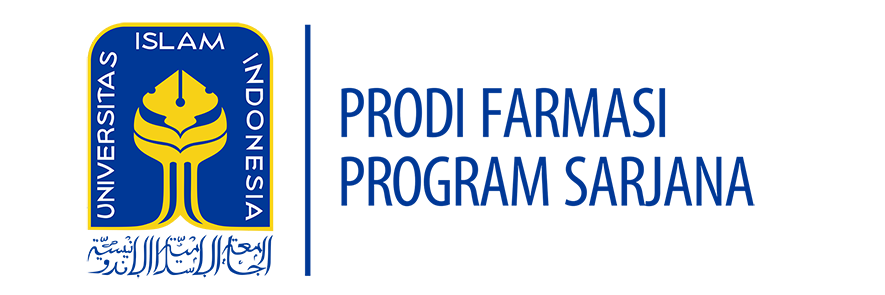COURSE INFORMATION
| Module Name | Basic Concepts of Therapy | ||||
| Module level, if applicable | 2nd Year | ||||
| Code, if applicable | SFA-440 | ||||
| Semester (s) in which the module is taught | Fourth Semester | ||||
| Person responsible for the module | Dr. Apt. Vitarani Dwi Ananda Ningrum, M.Si | ||||
| Lecturer(s) | Dr. Apt. Vitarani Dwi Ananda Ningrum, M.Si
apt. Yosi Febrianti, MSc. apt. Ndaru Setyaningrum, MSc. |
||||
| Language | Bahasa Indonesia and English | ||||
| Relation to curriculum | Compulsory course | ||||
| Types of teaching and learning | Class size | Attendance time (hours per week per semester) | Forms of active participation | Workload | |
| Lecture | 50 | 3 | Discussion | Lecture: 2 (hour) x 14 (meeting) | 28 |
| Preparation and follow up 4 (hour) x 14 (self-learning)
|
56 | ||||
| Interprofessional Education (IPE) | 50 | Report | Attendance time 1 (hour) x 12 (meeting) | 12 | |
| Preparation and follow up 4 (hour) x 14 (self-learning) | 24 | ||||
| Total workload | 120 hours | ||||
| ECTS | 4.29 ECTS | ||||
| Credit points | 3 CU | ||||
| Requirements according to examination regulations | Minimum attendance at lectures is 75% (according to UII regulation). Final score is evaluated based on assignment and reports (40%), mid semester exam (30%), and end semester exam (30%). | ||||
| Recommended prerequisites | Pharmacology | ||||
| Related course | – | ||||
| Module objectives/intended learning | By the end of this course students should be able to:
|
||||
| Content | This course is designed for discussing the concept of drug therapy. It covers the theory and concepts on the role of pharmacists and other healthcare workers as part of a health professional team in healthcare facilities, rational therapy, the pharmacokinetic-pharmacodynamic changes of drugs in a specific population based on the physiological approach, ADR, and SOAP method | ||||
| Study and examination requirements and forms of examination | Mid-term, Final term, assignments and presentation | ||||
| Media employed | Textbooks, slides (power points), video, Google classroom | ||||
| Reading lists |
ZjhmMWQ2OWNiYmZjOWFiYzA0NDdiZGJhNWYzMmNmZWUxMzZiMDMxYw==.pdf =vfe&ved=2ahUKEwjeqMuKyLnnAhWt4TgGHaXwAzwQr4kDegUIARDSAQ
|
||||
REQUIREMENTS
| Requirements according to examination regulations | Minimum attendance at lectures is 75% (according to UII regulation). Final score is evaluated based on assignment and reports (50%) and exam (50%) |
| Recommended prerequisites | – |
| Related course | – |
| Study and examination requirements and forms of examination | Mid-term, Final term, presentation, quiz, assignment, and collaborative discussion |
MODULE OBJECTIVES/INTENDED LEARNING
By the end of this course students should be able to:
- play an active role and apply discipline in the lecture process.
- explain the application of basic chemistry in pharmacy.
- understand the concept of stoichiometry in the pharmaceutical field.
- understand the concept of acid-base and reduction-oxidation reactions in the pharmaceutical field.
- understand the concept of reaction kinetics and the colligative properties of solutions in the pharmaceutical field.
Content
The course will cover:
- The physicochemical properties of medicinal compounds
- Stoichiometry, acid-base reactions, reduction-oxidation reactions, kinetics reaction, and the colligative nature of solutions.
Media employed
Text books, slides (power points), and video
Reading lists
- Cairns, D., 2008, Essentials Pharmaceutical Chemistry 3rd edition, Pharmaceutical Press, London.
- Harris, D. C., 2010, Quantitative Chemical Analysis Eighth Edition, W. H. Freeman and Company, New York.
- Reddy I. K., dan Khan M. A., 2004, Essential Math and Calculation for Pharmacy technicians, CRC Press, Boca Raton, Florida.
- Timberlake, K.C., 2015, Chemistry, An Introduction to General, Organic, and Biological Chemistry, 12th edition, Pearson Education Inc., USA.
- Sarker S.D., dan Nahar L., 2007, Chemistry for Pharmacy Students, John Wiley & Sons, Ltd., England.
- Beale J. M., Jr., dan Block J. H., 2011, Wilson and Gisvold’s Textbook of Organic Medicinal and Pharmaceutical Chemistry, twelfth edition, Lippincott Williams & Wilkins, Philadelphia
